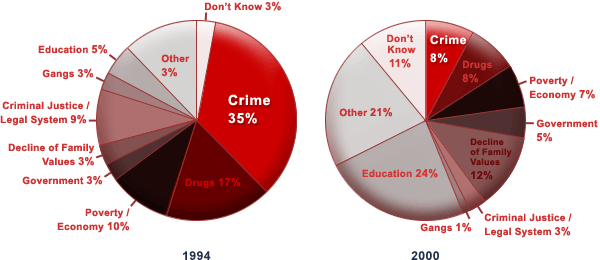| Setting the Agenda: "What do you consider to be the single most important problem facing the state?" |
 |
"A scary orgy of violent crime is fueling another public call to action," ran the lead of a January 17, 1994 U.S. News and World Report cover story on "Violence in America." This account seemed to have been confirmed by the Texas public in 1994. Thirty-five percent rated crime as the most important problem facing Texans. But by 2000 Texans had turned their attention to education and other matters. Just 8 percent identified crime as the most important problem facing Texas. Was a crime wave driving public concerns in 1994? Perhaps, but much more important was the mass media's depiction of crime. Gallup's national data shows that at no time between May 1989 and January 1993 did more than 9 percent of the public rate crime as most important. Yet by January 1994 national concern spiked to 37 percent. According to the Tyndall Report (Feb. 1994), network television spent an average of 157 minutes per month on crime – an average of more than two and a half hours – from October 1993 through January 1994. By contrast the networks averaged just 67 minutes per month between January 1989 and January 1992. As coverage spiked in 1994, a shrill tabloid style took over reporting. NBC Nightly News, for example, portrayed a "Society Under Siege" in a regular nightly feature. The O.J. Simpson case, which broke in June 1994, and other high-profile cases further fueled frenzied media coverage shaping public concerns. According to Gallup data, at least 20 percent of the national public continued to see crime as the most important national problem through 1998. As the frenzy subsided, that figure dropped to 13 percent by March 2000 and a mere 2 percent by June 2004. |
| Source: Texas Crime Poll; Sourcebook of Criminal Justice Statistics; FAIR. (full source) |